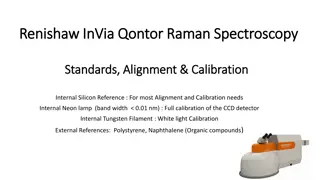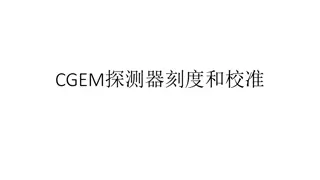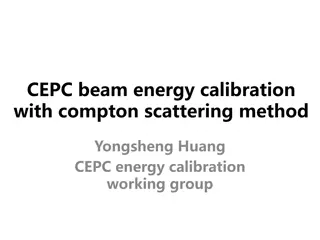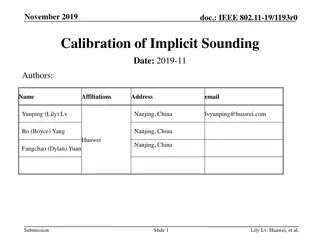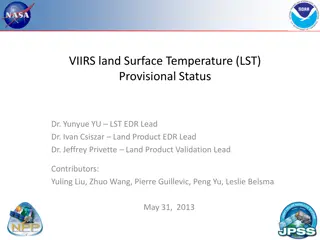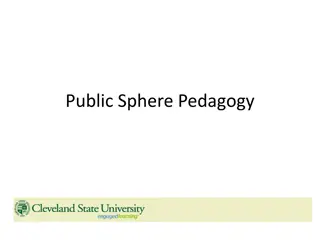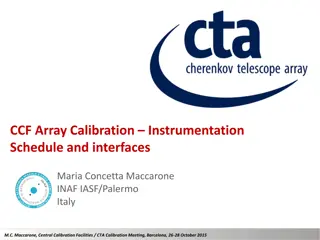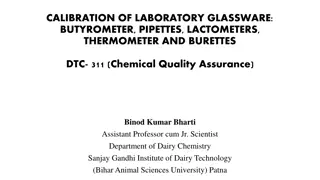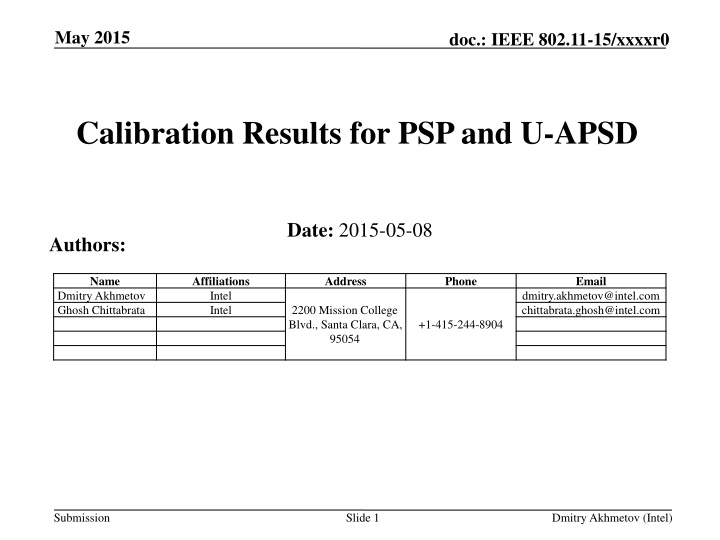
IEEE 802.11-15 Calibration Test Results for PSP and U-APSD
Comprehensive calibration test results for Power Save Polling (PSP) and Unscheduled Automatic Power Save Delivery (U-APSD) mechanisms in IEEE 802.11-15 document are presented. The study includes power consumption variations and state transitions for PSP and U-APSD, highlighting energy efficiency evaluations and differences. Detailed simulations and power state definitions are discussed, shedding light on power model parameters and common power states. The PSP test parameters, including data transmission frequency, packet lengths, beacon settings, and station behaviors, are outlined, providing insights into power save mode operations. The calibration test results report the percentages of STA and AP involvement in power save states, energy distributions, and active times for PSP and PSP-Energy scenarios.
Download Presentation

Please find below an Image/Link to download the presentation.
The content on the website is provided AS IS for your information and personal use only. It may not be sold, licensed, or shared on other websites without obtaining consent from the author. If you encounter any issues during the download, it is possible that the publisher has removed the file from their server.
You are allowed to download the files provided on this website for personal or commercial use, subject to the condition that they are used lawfully. All files are the property of their respective owners.
The content on the website is provided AS IS for your information and personal use only. It may not be sold, licensed, or shared on other websites without obtaining consent from the author.
E N D
Presentation Transcript
May 2015 doc.: IEEE 802.11-15/xxxxr0 Calibration Results for PSP and U-APSD Date: 2015-05-08 Authors: Name Affiliations Intel Intel Address Phone Email Dmitry Akhmetov Ghosh Chittabrata dmitry.akhmetov@intel.com chittabrata.ghosh@intel.com 2200 Mission College Blvd., Santa Clara, CA, 95054 +1-415-244-8904 Submission Slide 1 Dmitry Akhmetov (Intel)
May 2015 doc.: IEEE 802.11-15/xxxxr0 Abstract The Simulations Scenario document [1] described 3 existing power save mechanisms in 802.11-2012 as baseline for energy efficiency evaluation in scenarios for TGax Power save mode (PSM) Power save polling (PSP) Unscheduled automatic power save delivery (U-APSD) This contribution provides power save calibration test results for PSP U-APSD This contribution also provides differences in power consumption for PSP and U-APSD when state transitions time and power consumptions are considered additionally Submission Slide 2 Dmitry Akhmetov (Intel)
May 2015 doc.: IEEE 802.11-15/xxxxr0 Various Power States Definition Simulation Scenarios document [1] of IEEE 802.11ax specifies the following common power model parameters for all simulation scenarios Power State Average Current Consumption [mA] Transmit [mA] 280 Receive [mA] 100 Listen [mA] 50 Shallow Sleep [mA] 0.9 Deep Sleep [mA] 0.003 Deep Sleep [2] power state is defined as a sleep state with the least (non-zero) power consumed and the longest transition time to Listen state. Shallow Sleep [2] power state is defined as a sleep state when the STA consumes more power but transitions faster to Listen state when compared to the Deep Sleep power state Simulation results in this contribution use Shallow Sleep power state as Sleep state Dmitry Akhmetov (Intel) Submission Slide 3
May 2015 doc.: IEEE 802.11-15/xxxxr0 PSP Test The MSDU 1500 bytes DL traffic transmitted every 200ms PPDU length = 1920 us Beacon transmitted using PIFS Regular contention for PS-Poll & DATA STA wakes at TBTT boundary PS-Poll triggers AP to TX in DL STA enter SLEEP after it received DATA with more_frag bit set to zero Parameters RTS/CTS OFF AIFS= DIFS 34us 6 Mbps/ 6.5Mbps Control rate/Data rate MCS 0 No A-MPDU aggregation Simulation time 300s Beacon size(Byte) 80 BI 102.4ms DTIM 3 Submission Slide 4 Dmitry Akhmetov (Intel)
May 2015 doc.: IEEE 802.11-15/xxxxr0 Calibration Test Results for PSP PSP-Time STA(%) AP(%) Power save ON/OFF DTIM Listen RX TX Sleep Listen RX TX Sleep Active 3 98.82 1.12 0.02 0.00 98.86 0.02 1.12 0.00 PSP 3 0.09 1.03 0.04 98.78 98.80 0.04 1.14 0.00 PSP-Energy STA(%) AP(%) Power save ON/OFF DTIM Listen RX TX Sleep Listen RX TX Sleep Active 3 97.67 2.22 0.11 0.00 93.98 0.04 5.98 0.00 PSP 3 2.28 49.52 5.33 42.87 93.88 0.08 6.05 0.00 Submission Slide 5 Dmitry Akhmetov (Intel)
May 2015 doc.: IEEE 802.11-15/xxxxr0 U-APDS Test Bidirectional traffic, MSDU 120 bytes every 40ms AP buffer DL traffic while STA is in SLEEP STA wakes at UL frame arrival from LLC Regular contention for each DATA TX STA enter sleep after it receive DATA with more_frag bit set to zero & STA TX buffer is empty Parameters RTS/CTS OFF AIFS= DIFS 34us Control rate/Data rate 6 Mbps/ 6.5Mbps MCS 0 AP buffers the DL frame since the STA is in Power Save mode UL DATA is created and set immediately to transmission No A-MPDU aggregation DL DATA UL Simulation time 300s DATA AIFS SIFS AIFS SIFS Not Beacon Backoff modeled ACK DATA AP BI N/A STA DATA ACK ProbeDelay Backoff DTIM N/A STA Power State Sleep LI TX LI RX LI RX LI TX Sleep Transmit (TX) Listen (LI) Power State Receive (RX) Sleep Submission Slide 6 Dmitry Akhmetov (Intel)
May 2015 doc.: IEEE 802.11-15/xxxxr0 Calibration Test Results for U-APSD U-APSD-Time STA(%) AP(%) Power save ON/OFF Listen RX TX Sleep Listen RX TX Sleep Active 98.70 0.65 0.65 0.00 98.70 0.65 0.65 0.00 UAPSD 0.84 0.65 0.65 97.85 98.69 0.65 0.65 0.00 U-APSD-Energy STA(%) AP(%) Power save ON/OFF Listen RX TX Sleep Listen RX TX Sleep Active 95.23 1.25 3.51 0.00 95.23 1.25 3.51 0.00 UAPSD 11.11 17.24 48.28 23.37 95.23 1.25 3.51 0.00 Submission Slide 7 Dmitry Akhmetov (Intel)
May 2015 doc.: IEEE 802.11-15/xxxxr0 Different State Transitions in 802.11ax Submission Slide 8 Dmitry Akhmetov (Intel)
May 2015 doc.: IEEE 802.11-15/xxxxr0 Power and Latency Transitions Among States in IEEE 802.11ax [3] Power Consumption and Latency Values in State Transitions State Transitions Transition Time (ms) Power Consumption (mW) Transmit Listen TTL = 0.010ms 75mW Receive Listen 0ms 55mW Receive Transmit TRT = 0.004ms PRT = 100mW Transmit Shallow Sleep TTS = 0.01ms PTS = 15mW Receive Shallow Sleep TRS = 0.2ms PRS = 15mW Listen Shallow Sleep TLS = 0.2ms PLS = 5mW Shallow Sleep Listen TSL = 0.5ms Listen Deep Sleep TLD = 0.01ms PDS = 5mW Deep Sleep Listen TSDL= 3ms Submission Slide 9 Dmitry Akhmetov (Intel)
May 2015 doc.: IEEE 802.11-15/xxxxr0 PSP with Power Consumption and Latency Comparison during Transitions Power Save: Enable Total energy per state, W Power save : Disable Total energy per state, W STA AP STA AP NO TR TR % diff NO TR TR % diff NO TR TR % diff NO TR TR % diff Listen 0.02 0.01 6.99 Listen 16.30 16.30 0.01 Listen 16.31 16.31 0.00 Listen 16.31 16.31 0.01 RX 0.34 0.34 0.00 RX 0.01 0.01 0.00 RX 0.37 0.37 0.00 RX 0.01 0.01 0.00 TX 0.04 0.04 0.00 TX 1.05 1.05 0.00 TX 0.02 0.02 0.00 TX 1.04 1.04 0.00 Sleep 0.29 0.29 0.17 Sleep 0.00 0.00 0.00 Sleep 0.00 0.00 0 Sleep 0.00 0.00 0.00 Power Save: Enable Total time per state, s Power Save: Disable Total time per state, s STA AP STA AP NO TR TR % diff NO TR TR % diff NO TR TR % diff NO TR TR % diff Listen 296.47 296.46 0.00 Listen 296.57 296.53 0.01 Listen 0.28 0.26 6.99 Listen 296.40296.36 0.01 RX 3.37 3.37 0.00 RX 0.06 0.06 0.00 RX 3.08 3.08 0.00 RX 0.12 0.12 0.00 TX 0.06 0.06 0.00 TX 3.37 3.37 0.00 TX 0.12 0.12 0.00 TX 3.41 3.41 0.00 Sleep 0.00 0.00 0 Sleep 0.00 0.00 0.00 Sleep 296.35295.85 0.17 Sleep 0.00 0.00 0.00 Submission Slide 10 Dmitry Akhmetov (Intel)
May 2015 U-APSD with Power Consumption and Latency Comparison during Transitions doc.: IEEE 802.11-15/xxxxr0 Power Save: Disable Total energy per state, J Power Save: Enable Total energy per state, J STA AP STA AP NO TR TR % diff 0.04 Listen 16.29 16.28 0.00 RX 0.00 TX NO TR TR % diff 0.04 0.00 0.00 NO TR TR % diff NO TR TR % diff Listen 16.29 16.28 RX 0.21 TX 0.60 Listen 0.14 0.13 4.78 Listen 16.28 16.28 0.04 0.21 0.60 0.21 0.60 0.21 0.60 RX 0.21 0.21 0.00 RX 0.21 0.21 0.00 TX 0.60 0.60 0.00 TX 0.60 0.60 0.00 Sleep 0.00 0.00 0 Sleep 0.00 0.00 0.00 Sleep 0.29 0.29 1.30 Sleep 0.00 0.00 0.00 Power Save: Disable Total time per state, s Power Save: Enable Total time per state, s STA AP STA AP NO TR TR % diff NO TR TR % diff NO TR TR % diff NO TR TR % diff Listen 296.10295.98 0.04 Listen 296.10295.98 0.04 Listen 2.51 2.39 4.78 Listen 296.06295.94 0.04 RX 1.95 1.95 0.00 RX 1.95 1.95 0.00 RX 1.95 1.95 0.00 RX 1.95 1.95 0.00 TX 1.95 1.95 0.00 TX 1.95 1.95 0.00 TX 1.95 1.95 0.00 TX 1.95 1.95 0.00 Sleep 293.55289.72 1.30 Sleep 0.00 0.00 0.00 Sleep 0.00 0.00 0 Sleep 0.00 0.00 0.00 Submission Slide 11 Dmitry Akhmetov (Intel)
May 2015 doc.: IEEE 802.11-15/xxxxr0 Conclusion In this submission we have provided power save calibration test results provided results for enhanced power state modelling with consideration of power consumption and latency values during state transitions Submission Slide 12 Dmitry Akhmetov (Intel)
May 2015 doc.: IEEE 802.11-15/xxxxr0 References [1] S. Merlin et. al., TGax Simulation Scenarios, IEEE 11-14-980r6, Jan 2015 [2] C. Ghosh et. al., Sleep states in-IEEE 802.11ax Simulation Scenarios, IEEE 11-15-314r2, March 2015 [3] C. Ghosh et. al., Power Consumption and Latency Values in State Transitions for IEEE 802.11ax Simulation Scenarios, IEEE 11-15-0576r0, May 2015 Submission Slide 13 Dmitry Akhmetov (Intel)
May 2015 doc.: IEEE 802.11-15/xxxxr0 Back-up Slides Submission Slide 14 Dmitry Akhmetov (Intel)
May 2015 doc.: IEEE 802.11-15/xxxxr0 Some reference timing PSPOLL: ACK: Data, 1.5K (PSP test) Data, 120bytes (UAPSD test) Beacon, 80bytes 60us 40us 1920us 220us 168us at 6Mbps at 6Mbps at 6.5Mbps at 6.5Mbps at 6Mbps Submission Slide 15 Dmitry Akhmetov (Intel)







